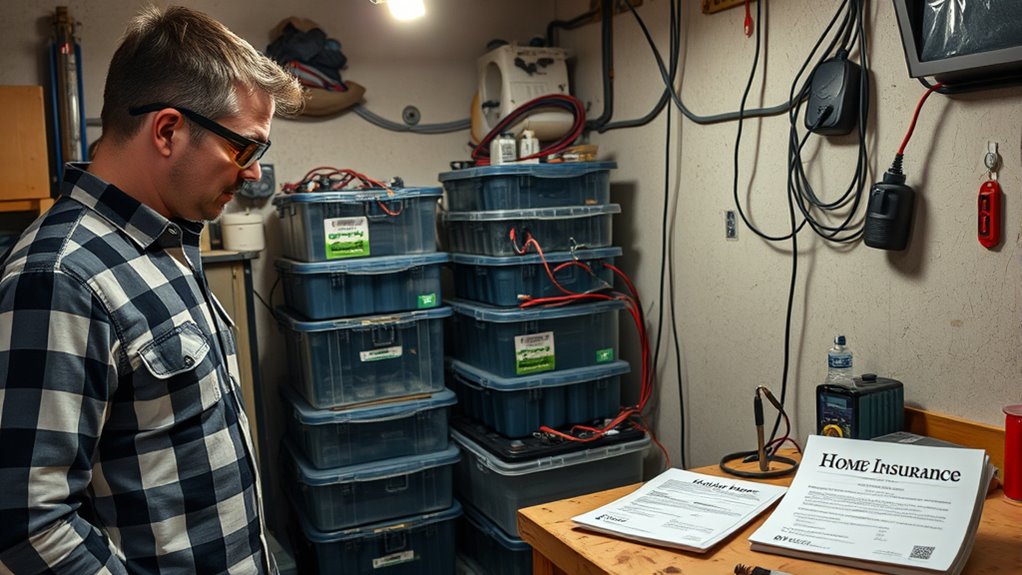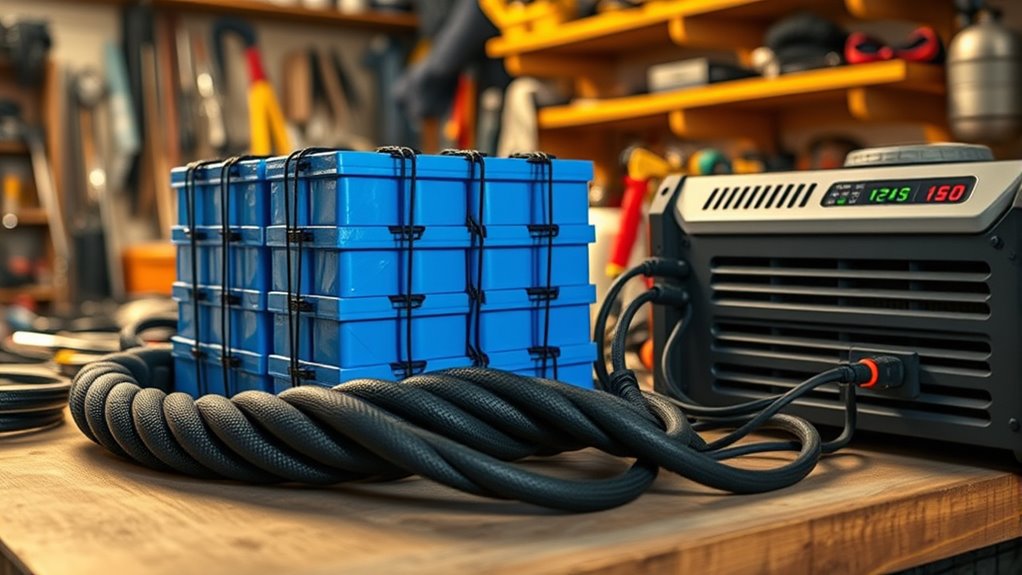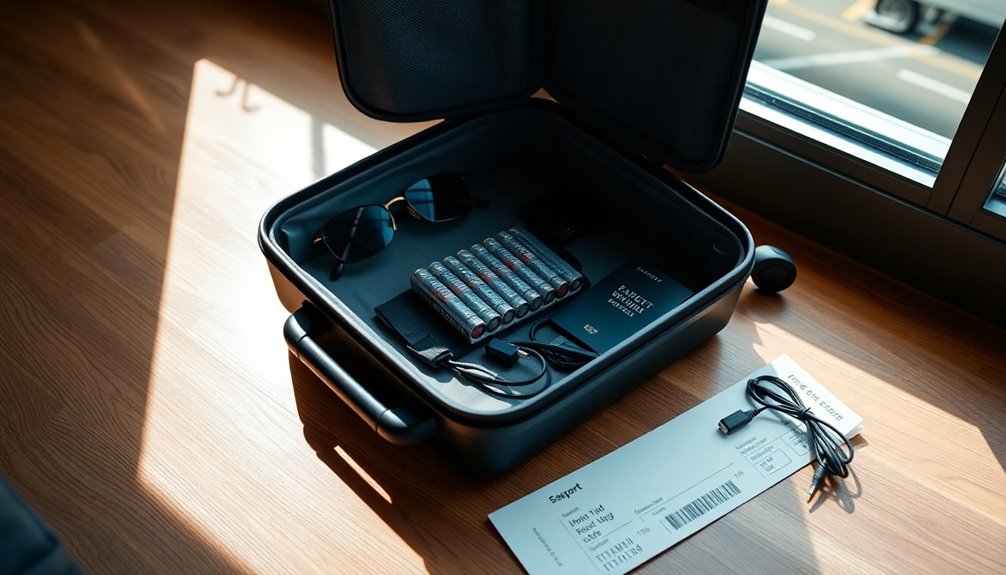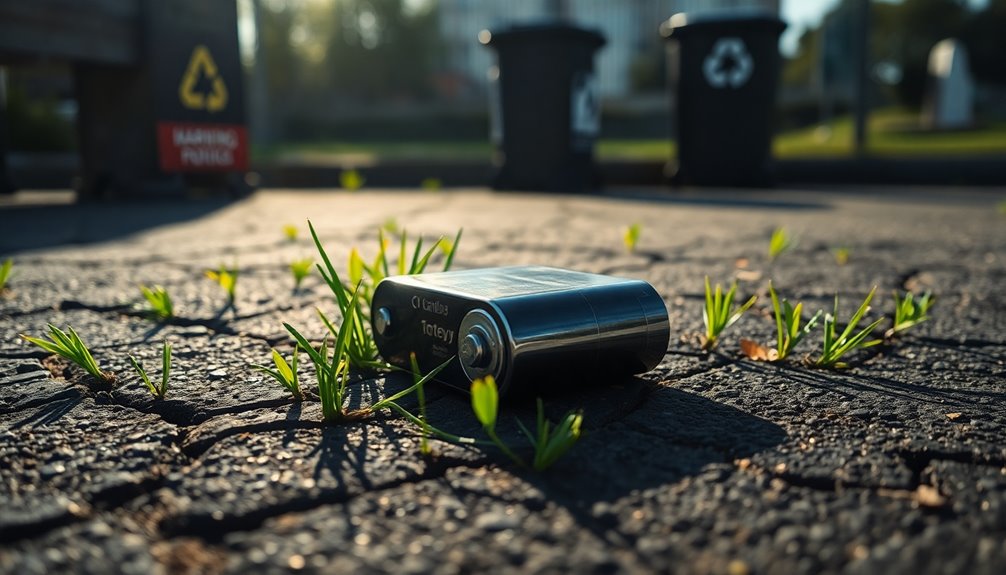Building a DIY battery bank can save money and increase energy independence, but it also carries safety risks that can affect your home insurance. Improper handling or unsafe installations may lead to fires or damage, potentially making your policy claims difficult or even denied. Many insurers view homemade systems as significant modifications and could exclude coverage if proper safety measures aren’t followed. To protect yourself and your home, it’s essential to understand these risks—more details can help you make informed decisions.
Key Takeaways
- DIY battery banks can pose fire risks, potentially leading to insurance claim denials if unsafe or non-compliant.
- Inform your insurer about your DIY system to ensure coverage and avoid claim issues.
- Proper safety measures and documentation are essential to support insurance claims after incidents.
- Many policies exclude damages caused by unprofessional or unsafe electrical modifications.
- Prioritize safety, adhere to local codes, and communicate with your insurer to protect your investment.

Building your own battery bank can be a cost-effective way to boost your home’s energy resilience, but it also raises important questions about how it might affect your insurance coverage. When you’re designing and installing a DIY battery system, battery safety should be at the forefront. Lithium-ion and lead-acid batteries, common in homemade setups, pose fire risks if improperly handled or damaged. Overlooking proper safety measures can lead to dangerous situations, which might not only threaten your home but also complicate insurance claims. Insurance companies scrutinize claims related to fire or property damage caused by DIY systems, especially if safety standards weren’t followed. If a fire occurs due to a poorly designed battery bank, your insurer may deny coverage or reduce the payout, arguing that negligence or unsafe practices contributed to the damage.
Understanding how your insurance policy views DIY battery banks is essential before you start construction. Many policies have specific clauses about modifications or additions to your home’s electrical systems, and installing a homemade battery bank could be considered a significant alteration. If you haven’t disclosed your project or if the system isn’t compliant with local safety codes, you might find yourself ineligible for coverage when a claim arises. Some insurers also have exclusions related to fire or damage caused by electrical systems that aren’t professionally installed or certified. To protect yourself, you should review your policy carefully and consider informing your insurer about your plans. Getting written confirmation that your DIY battery bank is covered can save you headaches later.
Additionally, proper battery safety practices aren’t just about preventing fires—they also involve ensuring the system’s stability and avoiding electrical hazards. This means using quality components, following manufacturer guidelines, and installing safeguards like circuit breakers and smoke detectors. Neglecting these precautions might lead to system failure, damage, or injury, all of which could impact your insurance claims. If an incident occurs and your system was not installed with safety in mind, your insurer could view it as preventable and refuse to cover damages. Conversely, maintaining high safety standards and keeping thorough documentation of your installation can strengthen your position when filing insurance claims, demonstrating that you took all reasonable steps to prevent accidents. Moreover, understanding the beneficial ingredients in eye patches can help you choose the most effective products for your skincare routine.
Ultimately, while building a DIY battery bank offers significant benefits, it’s essential to understand its implications on your home insurance. Prioritize safety, stay compliant with local laws, and communicate openly with your insurer. Doing so can help you enjoy the advantages of your energy system without jeopardizing your coverage or facing unexpected financial setbacks.
Frequently Asked Questions
Are DIY Battery Banks Covered by Standard Home Insurance Policies?
Your DIY battery bank might not be covered under standard home insurance policies. Typically, policies don’t include battery insurance or DIY coverage for homemade energy systems. If you want protection, you’ll need to check with your insurer and consider specialized coverage options. Keep in mind, many policies exclude DIY projects, so it’s essential to clarify your coverage and possibly seek additional insurance to safeguard your DIY battery bank.
What Safety Measures Are Recommended for DIY Battery Bank Installations?
Think of your DIY battery bank as a sleeping giant—you need to tame it with care. Follow strict installation guidelines and prioritize battery safety to prevent sparks from turning into wildfires. Use proper wiring, avoid overloading, and make sure good ventilation is in place. Wear protective gear, keep a fire extinguisher nearby, and double-check connections. These safety measures keep your energy powerhouse a helpful friend, not a hazardous foe.
How Does Installing a DIY Battery Bank Affect Home Insurance Premiums?
Installing a DIY battery bank can influence your home insurance premiums through policy modifications. While some insurers offer insurance discounts for upgraded safety features, others may increase premiums due to perceived risks. You should check with your insurer beforehand to understand how your installation might impact your policy. Being proactive guarantees you avoid surprises and possibly secure discounts, but always prioritize safety to prevent claim issues later.
Can DIY Battery Banks Cause Fire Hazards or Other Risks?
Like a double-edged sword, DIY battery banks can pose fire hazards if not properly built and maintained. You might face serious fire safety risks, including overheating or short-circuits, which could lead to fires. These risks also raise liability concerns, especially if damage occurs. To avoid trouble, make sure your DIY setup follows safety guidelines, uses quality components, and regularly inspects the system to mitigate potential hazards.
What Steps Should I Take for Insurance Claims Related to DIY Battery Bank Damages?
When filing an insurance claim for DIY battery bank damages, start by reviewing your policy to understand coverage. Next, document all damages thoroughly with photos and detailed descriptions. Contact your insurance provider promptly and follow their instructions for the claim process. Confirm you meet all documentation requirements, like receipts or proof of installation, to support your claim. Staying organized and prompt helps streamline the insurance claim process and improves your chances of a favorable outcome.
Conclusion
So, as you weigh the sparks of innovation against the storm clouds of risk, remember: your home insurance is the compass guiding your DIY battery journey. Ignoring this essential guide could turn your bright idea into a costly storm. Don’t let a DIY project become a cautionary tale—be informed, stay protected, and keep your home’s safety shining as brightly as your ambitions. After all, foresight is the best battery for any adventure.










